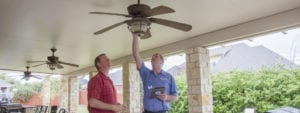
How Much Do Electricians Charge To Install a Ceiling Fan in 2024?
Installing a ceiling fan is a popular home improvement project that can improve air circulation and add style to a room. However, the task involves electrical wiring, which can be complicated and risky for those without experience. Hiring a professional electrician ensures the installation is safe and up to code. In 2024, several factors influence the cost of hiring an electrician to install a ceiling fan, including the complexity of the installation, the type of fan, and regional labor rates.
Understanding the Costs of Ceiling Fan Installation
Installing a ceiling fan is a task that, while seemingly straightforward, involves several variables that can significantly affect the overall cost. Whether you’re updating an old fan, replacing a light fixture with a new fan, or installing a fan in a brand-new location, each scenario carries its own set of challenges and costs. Here’s a deeper look into what contributes to the cost of ceiling fan installation and how to budget for this project.
Basic Installation Costs
The cost to hire an electrician in 2024 generally ranges from $100 to $250 for basic ceiling fan installation. This price typically assumes that there is an existing fixture and working wiring in place. The job mostly involves replacing a light fixture with a fan, which is relatively straightforward for a professional.
Type of Installations
- New Installations: If a new fan is being installed where no fixture currently exists, the cost can be higher, typically ranging from $200 to $400 or more. This type of installation involves running new wiring, adding a switch, and possibly reinforcing the ceiling support. In some cases, access to wiring through attics or behind walls may require additional labor, which can increase costs.
- Replacement Installations: If you are replacing an existing ceiling fan with a new one, the installation process is typically straightforward and less costly. The wiring and supports required for the fan are already in place, which simplifies the task for the electrician. Installation costs in such cases are usually on the lower end of the spectrum, generally ranging from $100 to $200.
- Special Installations: For installations that involve high ceilings, special mounts, or fans that are particularly large or heavy, costs can increase significantly. High ceilings may require scaffolding or special ladders, and sloped ceilings need special mounting brackets to ensure the fan hangs properly and operates safely. These specialized installations can cost anywhere from $150 to $500.

High or Sloped Ceilings
Installing a fan on high or sloped ceilings can also increase the cost due to the additional equipment and labor required. Special mounts may be needed for sloped ceilings, and extra safety measures may be necessary for high ceilings. Prices for these installations can range from $150 to $500, depending on the height and angle of the ceiling.
Luxury or Specialized Ceiling Fans
The type of ceiling fan also affects installation costs. High-end fans, or those with additional features like remote controls, built-in lighting, or energy-efficient designs, can require more time or special handling during installation. Costs for these types of installations typically range from $250 to $600.
Regional Labor Rates
Labor costs can vary significantly depending on where you live. Urban areas and regions with higher living costs tend to have higher rates for electrician services. It’s always a good idea to get multiple quotes from local electricians to find the best rate in your area.
Fan Features and Accessories
The type of ceiling fan you choose also impacts the installation cost. Standard fans are typically less expensive to install than those with additional features such as remote controls, built-in lights, or energy-efficient technology.
- Fans with Lights: If you choose a ceiling fan with an integrated light, the installation might take a little longer, particularly if the wiring scheme in your home needs to be adapted to accommodate a dual function.
- Remote-Controlled and Smart Fans: Fans equipped with remote controls or those that can be integrated with smart home systems require additional setup and configuration, which may increase labor costs.
- Energy-Efficient Fans: While the installation cost for an energy-efficient fan may be similar to that of a standard fan, the overall savings on energy costs can offset this expense over time.

Electrical Upgrades
In older homes, or in cases where the existing electrical system does not meet the power requirements of the new fan, electrical upgrades may be necessary. This could involve replacing old wiring, adding new circuits, or upgrading the electrical panel to handle the additional load. These modifications will increase the overall cost of the installation but are crucial for safety and functionality.
Labor Rates
Labor costs can vary significantly depending on geographic location and the individual electrician or company you hire. Urban areas typically have higher rates than rural areas due to higher costs of living and doing business. Always check local rates and get multiple quotes to ensure you are getting a fair price for your installation.
Additional Considerations
Electrical Panel and Wiring Check
Before installing a new ceiling fan, an electrician may need to check your home’s electrical panel and wiring to ensure they can handle the additional load. If upgrades are needed, this can significantly increase the cost.
Switches and Controls
If you’re adding a fan where there was previously just a light, you might want additional switches installed for independent control of the fan and light features. Adding a new switch can cost between $100 to $200.
Dimmer Switches and Remote Controls
For fans with lights, you might consider adding a dimmer switch or opting for a model with a remote control. Installation of these features will add to the overall cost but can provide enhanced functionality and convenience.

Tips for Hiring an Electrician in 2024
Hiring a qualified electrician is crucial for ensuring that any electrical work in your home or business is done safely, efficiently, and up to code. With the constant advancements in electrical systems and smart home technology, the criteria for choosing an electrician in 2024 are more stringent than ever. Here’s a detailed guide on what to look for and how to determine if an electrician is qualified for the job.
Evaluate Credentials and Experience
The first step in assessing an electrician’s qualifications is to check for a valid license. In most jurisdictions, electricians must be licensed to perform electrical work legally. A valid license indicates that the electrician has met the minimum standards of training and knowledge as required by state or local laws. Ensure that the electrician carries adequate liability insurance and is bonded. This protects you in case of damage to your property or injuries to the electrician while on your job. Ask to see proof of insurance and check that the policy is active. Experience is particularly important in the electrical trade. Look for an electrician who has specific experience with the type of project you are undertaking. For example, if you are installing smart home devices, look for someone who has specialized knowledge in smart technology.
Check References and Reviews
Ask for and check references. Speaking to past clients can provide insights into the electrician’s quality of work, reliability, and customer service. It’s also a good opportunity to ask about the specifics of their projects and how satisfied they were with the completed work. Check online reviews on platforms such as Yelp, Google, or Angie’s List. Pay attention to both positive and negative reviews to gauge the overall reliability and professionalism of the electrician. Be wary of contractors with multiple negative reviews, especially those mentioning issues like overcharging, poor communication, or shoddy workmanship.
Assess Professionalism and Communication
Pay attention to your first interaction with the electrician. Are they punctual for your appointment? Do they communicate clearly and professionally? First impressions can be indicative of the level of service you will receive. Effective communication is crucial, especially for complex projects. The right electrician should be able to explain technical issues in terms that you can understand and keep you informed throughout the process.
Compare Quotes
Get at least three quotes from different electricians to compare prices and scope of work. Ensure these quotes are detailed and itemized, listing out the cost for parts, labor, and any other charges. This transparency helps prevent unexpected costs and allows you to make an informed decision based on cost and the services provided. Ensure that the scope of work is clearly defined and agreed upon. A professional electrician should provide a written agreement that outlines the entire project, including the tasks to be performed, the timeline, and the payment schedule.

Ongoing Training and Certifications
With the electrical field constantly evolving, ongoing education is essential. Ask if the electrician participates in continuing education courses or holds any additional certifications, especially those related to newer technologies or safety practices. Depending on your needs, you might require an electrician with specific specializations, such as solar installations, home automation, or commercial lighting. Check for certifications or documented experience in these areas.
Hiring the right electrician is about more than just finding someone to get the job done. It’s about ensuring safety, reliability, and quality workmanship. By thoroughly vetting potential electricians based on their credentials, experience, professionalism, and the clarity of their quotes, you can feel confident in your choice and secure in the knowledge that your electrical work is in good hands.
The cost to install a ceiling fan by an electrician in 2024 varies widely based on the specifics of the installation and regional factors. While it might be tempting to attempt this task yourself to save money, ceiling fan installation can involve complex electrical work that is best left to professionals. Investing in professional installation not only ensures safety but also guarantees that the fan operates efficiently and effectively.


Leave a Reply